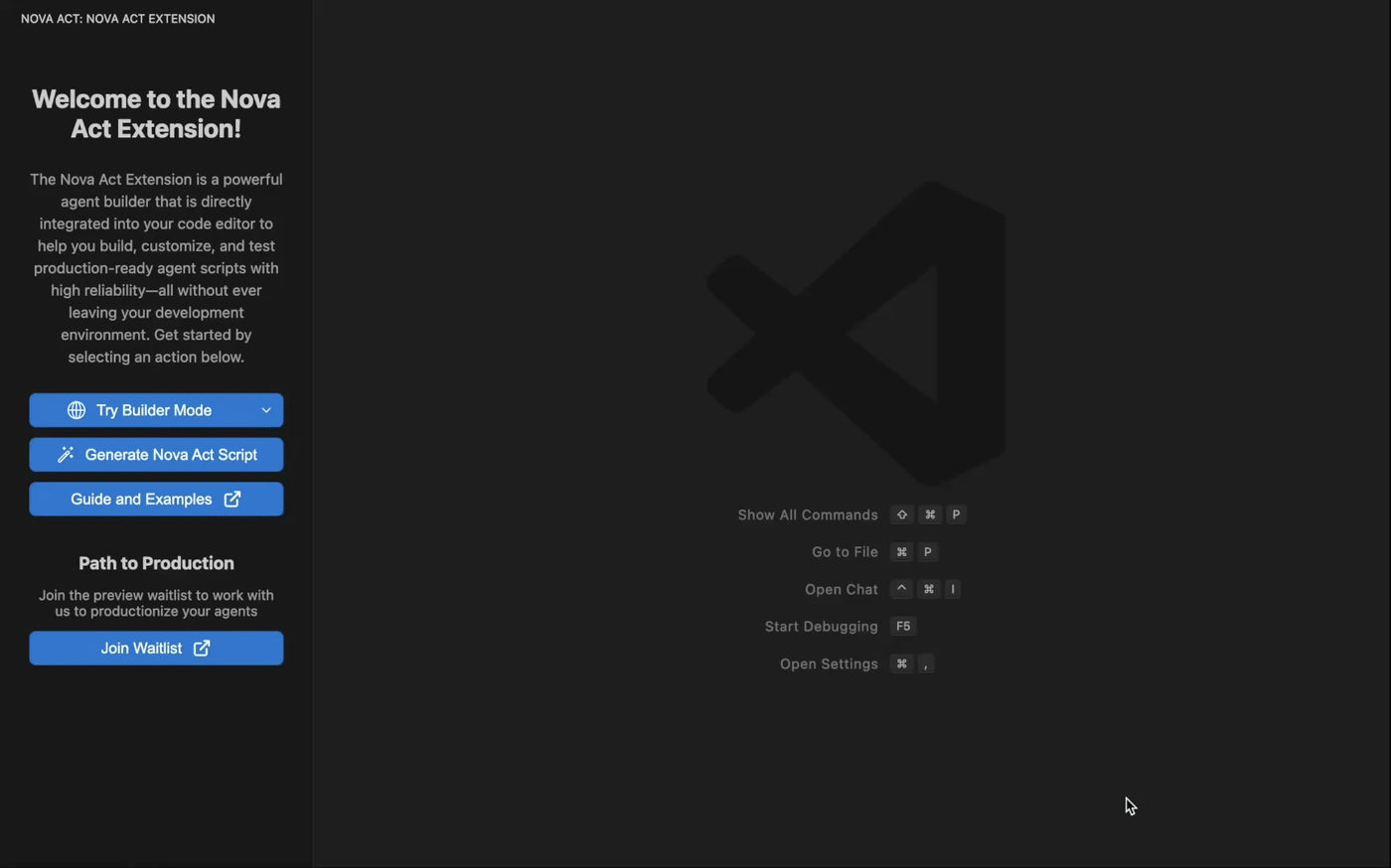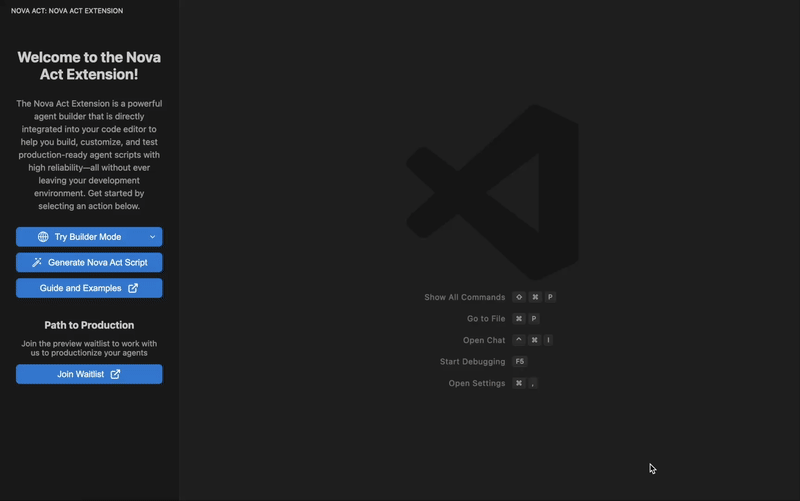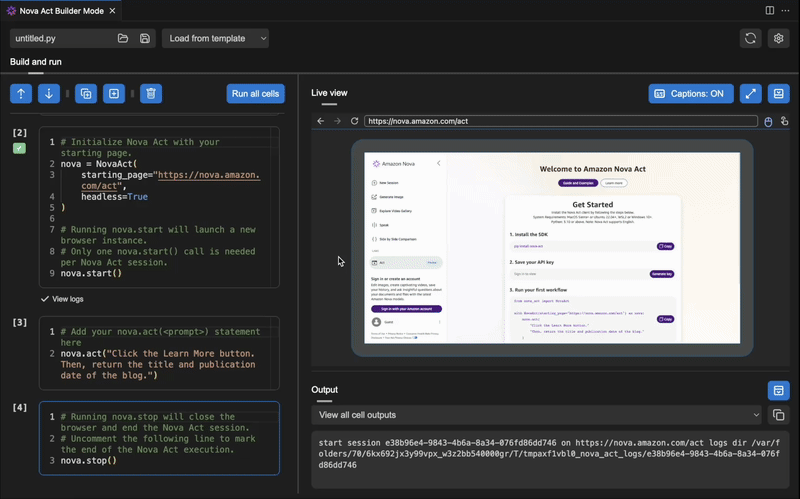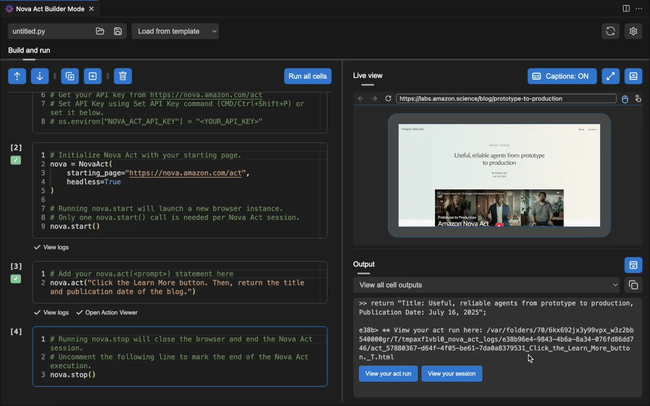Since launching Amazon Nova Act and the research preview SDK in March, it’s been amazing to watch developers successfully build AI agents that automate enterprise workflows from form-filling to QA testing, shopping, and data extraction. While Nova Act delivers the reliability and flexibility needed for these tasks, the workflow development process is a lot of work. Developers constantly switch between their integrated development environment (IDE) and browser, wait for test runs, and struggle to debug complex workflows.
Today, we're introducing the Nova Act extension, a tool that transforms how you build with Nova Act by bringing the entire agent development experience directly into IDEs like Visual Studio Code, Kiro, and Cursor.
The development velocity challenge
If you've worked with Nova Act (or any agent framework), you'll recognize this pattern: you spend most of your time iterating between building and testing. Write some prompts and code in your IDE, switch to your browser to run it, inspect logs to figure out what went wrong, head back to your IDE to make changes, then run the entire workflow again from the beginning, even when you're only tweaking one small part.
This constant context-switching doesn't just slow you down—it completely disrupts your creative flow. A five-minute fix becomes an hour-long ordeal. We feel your frustrations, particularly around the time spent validating agent behavior while building and running scripts.
End-to-end agent development
The Nova Act extension unifies agent development, testing, and debugging into a single IDE environment. No more switching between tools or losing your train of thought. The extension brings your code editor, browser, and debugging tools into a single workspace that's designed specifically for building agents.
Chat-to-script generation: Start with a conversation
Remember the first time you tried automating a workflow with Nova Act? You probably spent hours setting up boilerplate code before getting to the actual logic. With the extension's Script Generation feature, you can now describe your automation needs in natural language and get execution-ready agent scripts in minutes.
For instance, if you're building a form-filling workflow, instead of starting from scratch, you might say: "I need an agent that logs into a customer portal, searches for unresolved tickets, and updates their status based on completion criteria." The extension generates a functional script that handles the authentication flow, navigation, search functionality, and status updates, giving you a solid foundation to build on.

Step-by-step builder: Build and test cell by cell
Anyone who's built complex workflows knows the pain of making a small change and having to run the entire script again. Our notebook-style builder changes this completely by letting you execute your script cell-by-cell.
Imagine you're building an agent that automates a product search and checkout flow. You've got the search working perfectly, but the checkout keeps failing at the payment step. Instead of running the entire workflow from the beginning each time, you can focus just on the payment cell—testing different approaches, tweaking parameters, and validating results in real-time.
This modular approach means you can develop incrementally, adding cells, reordering them, and interleaving act() statements with regular Python code to build a robust agent one piece at a time. It's how we've always wanted agent development to work.

Live debugging: Watch your agent think and act
The biggest frustration we've heard from developers is the disconnect between seeing what the agent is doing in the browser and understanding why it's making certain decisions based on console logs. You're constantly alt-tabbing between views, trying to correlate actions with output.
Our live debugging interface solves this by bringing your code, browser view, and thinking and action logs into a single, cohesive experience within your IDE. You can now watch your agent execute while simultaneously monitoring its decision-making process, seeing exactly what it sees, why it makes each choice, and where things might go wrong.
You can pause execution at any point to make adjustments, then resume testing without starting over. You can even multitask while the agent runs, editing code during execution and re-running cell by cell—something that simply wasn't possible with the SDK's headed mode.

Action viewer: Review and compare workflow versions
After your agent completes a run, the Workflow Viewer lets you examine everything that happened at whatever level of detail you need. Select "view your act run" for insights into a single act() statement or "view your session" to analyze the entire end-to-end workflow.
What makes this particularly powerful is the ability to compare multiple runs side-by-side as you iterate on your scripts. You can easily spot improvements or regressions without having to manually sift through separate HTML files or log outputs. It's like having a visual history of your agent's evolution.

Built for every developer's journey
We designed the Nova Act extension to scale with your development needs, whether you're just starting out or building enterprise-grade automation. Begin quickly with Script Generation for chat-based prototyping, then progress to Builder Mode for fine-tuning, and finally integrate with production systems using the full power of the Nova Act SDK—all from within your familiar IDE environment.
One of our partners at Hertz, Mu Qiao, shared their team's experience: "Before the extension, validating a complex workflow took a full day of back-and-forth testing. Now we iterate in minutes. The live debugging alone cut our development time by 50%."
The extension works seamlessly with the Nova Act SDK, giving you the same high reliability on step-level actions while adding flexible integration options with your own code patterns or frameworks like Strands Agents and the Amazon Bedrock AgentCore Browser Tool. This bring-your-own approach keeps you in control without locking you into a rigid architecture.
Under the hood
Enterprise adoption of AI agents is at an inflection point. The technology is increasingly capable, but the way we teach and customize the underlying models has been the bottleneck. The Nova Act extension bridges that gap, making it possible to build reliable agents faster than before.
The Nova Act extension builds directly on the Nova Act SDK, accelerating your workflow development while maintaining the same reliability you've come to expect. We've enhanced the SDK with features like bi-directional communication, allowing model thinking and actions to be overlaid on the live browser view, similar to video captions, and giving you clearer insight into your agent's behavior.
Get started today
This is just the beginning. As we continue to evolve Nova Act, we'll be adding more extension templates and features based on your feedback and use cases. Our goal is to make agent development not just powerful, but also intuitive and enjoyable.
Generate your Nova Act API key on nova.amazon.com/act and install the Nova Act extension in your IDE. Check out our GitHub repo to report issues or contribute, and join us in building the future of AI agents that don't just work, but work reliably at scale.